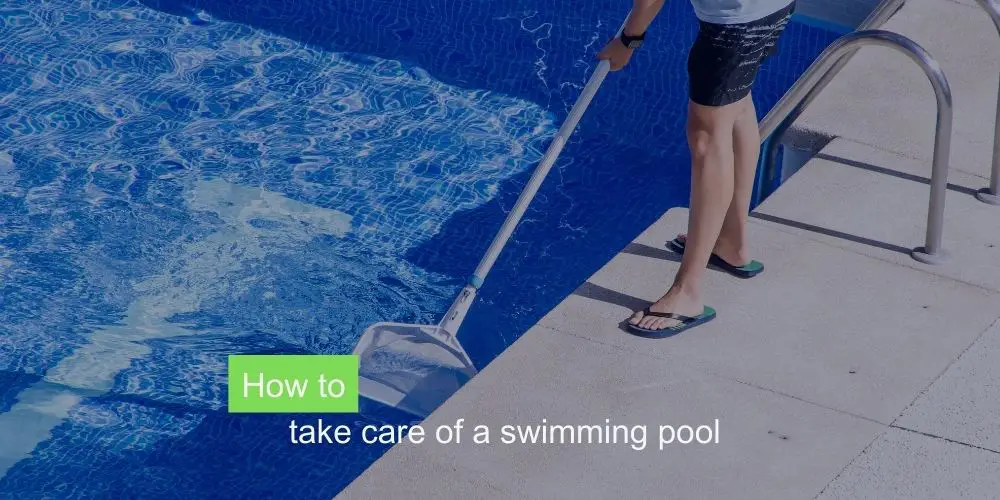
Proper pool maintenance is essential for the enjoyment and longevity of your swimming pool. It ensures the safety of swimmers, extends the lifespan of your pool and equipment, and enhances your overall swimming experience. In this blog post, we will explore the importance of pool maintenance, the proper ways for taking care of a swimming pool, and the benefits of owning a well-maintained pool. We will also provide a structured guide covering everything from preparing for maintenance to troubleshooting common issues. Let’s dive in and discover how to take care of your swimming pool effectively.
How to Take Care of A Swimming Pool

Preparing for Pool Maintenance
Before diving into regular pool maintenance, it’s important to make the necessary preparations. This section will guide you through the steps to ensure you’re ready to take care of your pool effectively.
Gathering the Necessary Tools and Equipment
To properly maintain your swimming pool, you’ll need a set of essential tools and equipment. These may include a telescopic pole, skimmer net, pool brush, pool vacuum, water testing kit, pH adjusters, pool chemicals, and a pool cover. By having these items on hand, you’ll be well-equipped to handle routine maintenance tasks.
Setting up a Pool Maintenance Schedule
Consistency is key when it comes to pool maintenance. Establishing a regular pool maintenance schedule will help you stay on track and ensure that necessary tasks are completed on time. Whether you choose to perform maintenance tasks daily, weekly, or monthly, having a schedule in place will make it easier to manage and maintain your pool’s cleanliness and functionality.
Understanding Pool Chemistry Basics
Maintaining proper water chemistry is vital for a healthy and safe swimming environment. It’s crucial to understand the basics of pool chemistry, including pH levels, chlorine or alternative sanitizers, alkalinity, and calcium hardness. Regular testing and balancing of these chemical levels will help prevent issues such as algae growth, cloudy water, and skin irritations. Familiarize yourself with the ideal ranges for each parameter and learn how to adjust them accordingly.
Daily Pool Maintenance Routine
Once you have your pool maintenance preparations in order, it’s time to establish a daily maintenance routine. These regular tasks will help keep your pool clean and inviting on a day-to-day basis.
Skimming and Removing Debris
Using a skimmer net attached to your telescopic pole, skim the pool’s surface to remove leaves, insects, and other debris. This prevents them from sinking to the bottom or clogging the pool’s circulation system.
Brushing and Vacuuming the Pool
Brush the pool walls, steps, and corners to remove any algae or dirt buildup. This is especially important for concrete or tiled pools. Additionally, vacuum the pool floor to eliminate any debris that has settled.
Checking and Adjusting Water Level
Regularly monitor and maintain the water level of your pool. If it falls below the recommended range, use a garden hose to top it up. On the other hand, if it’s too high, drain some water using the appropriate drainage system or a submersible pump.
Weekly Pool Maintenance Tasks
In addition to your daily routine, certain tasks should be performed on a weekly basis to maintain optimal pool conditions.
Testing Water Chemistry and Balancing Chemical Levels
Use a water testing kit to check the chlorine, pH, alkalinity, and calcium hardness levels of your pool water. Based on the results, adjust the chemical levels accordingly using the recommended products. This ensures that the water remains balanced and safe for swimming.
Cleaning Pool Filters and Skimmer Baskets
Clean the pool filters and skimmer baskets to remove any debris or particles that may be blocking the flow of water. This improves filtration efficiency and helps maintain clean and clear pool water.
Scrubbing Pool Tiles and Walls
Scrub the pool tiles and walls using a pool brush to remove any algae, calcium deposits, or dirt buildup. Regularly cleaning these surfaces not only enhances the pool’s appearance but also prevents the accumulation of stubborn stains.
Monthly Pool Maintenance Checklist
On a monthly basis, there are additional tasks that require attention to ensure the overall health and longevity of your pool.
Inspecting and Cleaning Pool Equipment
Check the pool equipment, including pumps, filters, heaters, and lights, for any signs of damage or wear. Clean the equipment as necessary and address any maintenance issues promptly to prevent further complications.
Shocking the Pool
Shocking the pool involves adding a higher dose of chlorine or other oxidizing agents to eliminate bacteria, algae, and other contaminants. This process helps maintain water clarity and quality. Follow the manufacturer’s instructions for the appropriate shock treatment for your pool.
Checking and Maintaining Pool Water Circulation
Ensure that your pool’s circulation system, including pumps and valves, is functioning properly. Check for any leaks, inspect the water flow, and adjust valves as needed to maintain consistent circulation and filtration.
Seasonal Pool Maintenance Considerations
As the seasons change, certain maintenance tasks should be tailored to accommodate specific seasonal needs and conditions.
Preparing the Pool for Winter
If you live in an area with cold winters, it’s important to winterize your pool to protect it from freezing temperatures. This typically involves draining water from the pool, adding winterizing chemicals, and covering the pool to prevent debris accumulation.
Opening the Pool for Summer
When the warmer months arrive, it’s time to prepare your pool for summer fun. This process includes removing the pool cover, cleaning and testing the water, checking the equipment, and adjusting chemical levels to ensure a safe and enjoyable swimming season.
Addressing Algae Growth and pH Imbalances
Algae growth and pH imbalances are common challenges for pool owners. Monitor the pool water regularly, especially during the warmer months, and address any signs of algae or pH fluctuations promptly. By maintaining proper chemical balance and implementing preventive measures, you can keep algae at bay and enjoy crystal-clear water throughout the swimming season.
Troubleshooting Pool common Issues
Even with regular maintenance, occasional pool issues may arise. This section will guide you through common pool problems and provide effective solutions to address them promptly.
Common Pool Problems and Solutions
- Algae Growth: Algae can quickly turn your pool water green and make it uninviting for swimmers. To combat algae, shock the pool with an appropriate dose of chlorine or algaecide, scrub the pool surfaces, and ensure proper filtration and water circulation. Maintaining proper chemical levels and regular brushing can help prevent algae growth.
- Cloudy Water: Cloudy pool water can be caused by various factors, such as improper water balance, insufficient filtration, or excessive debris. Test and balance the water chemistry, clean or backwash the filters, and maintain a regular cleaning routine to keep the water clear. If the problem persists, consult a pool professional for further guidance.
- Low Water Flow: Insufficient water flow can result from clogged filters, a malfunctioning pump, or blocked skimmer baskets. Clean the filters and baskets, check for any obstructions in the circulation system, and ensure the pump is functioning correctly. If the issue persists, seek professional assistance.
Dealing with Green or Cloudy Pool Water
- Green Pool Water: Green pool water indicates the presence of algae. Start by testing the water chemistry and adjusting the pH and chlorine levels as needed. Shock the pool with a high dose of chlorine or algaecide, and run the filtration system continuously until the water clears. Regular brushing and skimming will help remove dead algae and prevent its return.
- Cloudy Pool Water: Cloudiness in the pool water can stem from imbalanced chemistry, inadequate filtration, or excessive debris. Test the water and adjust chemical levels accordingly. Clean or backwash the filters to improve filtration efficiency, and remove any visible debris. Consider using a clarifier or flocculant to help clear the water. Allow the filtration system to run continuously until the water becomes clear.
Handling Pool Equipment Malfunctions
- Pump Issues: If the pool pump fails to start or operates irregularly, check for tripped circuit breakers, loose connections, or clogged impellers. Clear any obstructions, ensure proper electrical connections, and clean or replace the pump’s impeller if necessary. If the problem persists, consult a pool professional.
- Filter Problems: If the pool filter is not effectively removing debris or if the pressure gauge indicates high pressure, clean or backwash the filter according to the manufacturer’s instructions. If the filter media is worn out or damaged, replace it. Regular maintenance and cleaning of filters are essential to ensure optimal performance.
- Heater Troubles: If the pool heater fails to heat the water or produces insufficient heat, check for clogged filters, closed valves, or faulty thermostat settings. Clean or replace the filters, open valves to allow proper water flow, and adjust the thermostat as needed. If the issue persists, contact a professional technician for assistance.
Final Thoughts
Maintaining a swimming pool is a rewarding responsibility that requires regular care. By following a structured maintenance routine, troubleshooting common pool issues, and enhancing pool safety measures, you can create a clean, safe, and enjoyable swimming environment. Consistency is key in pool maintenance to prevent costly repairs and ensure long-term enjoyment of your pool. Embrace the journey of pool ownership with the knowledge and tips shared in this blog post. Dive in and enjoy your well-maintained swimming pool!

Hi, This is Josh. I am a former competitive swimmer and current fitness enthusiast.
I created this site to share my love of swimming with the world!
